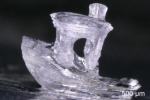
New Holographic TVAM 3D Printing Method Accelerates Production
3dprintingindustry.com
A team of Europe-based researchers has developed a novel holographic 3D Printing method. The group created a modified Tomographic Volumetric Additive Manufacturing (TVAM) technique capable of shortening 3D printing times to mere seconds while increasing efficiency.Unlike conventional layer-by-layer 3D printing methods, TVAM can create entire objects in one shot by shining light patterns into liquid resin, which solidifies when the light intensity is high enough. While this approach can fabricate support-free, micro-scale parts within tens of seconds, it is highly inefficient. This is because under 1% of the encoded light reaches the resin vial. Conventional TVAM can also lead to unwanted distortions and poor resolution due to light blurring and projection artifacts.To address these limitations, the researchers developed HoloVAM, a new technique that uses a 3D hologram instead of conventional volumetric light projections. This approach reportedly boosts light efficiency by 20 times, resulting in faster and more accurate 3D printing. According to their paper, published in Nature Communications, HoloVAM successfully fabricated several millimeter-scale objects in under 60 seconds with fine details as small as 31 micrometers.The scientists behind the discovery are based between the Laboratory of Applied Photonic Devices at Switzerlands EPFL and the University of Southern Denmarks Centre for Photonics Engineering. They believe this new approach offers value for medical bioprinting applications, thanks to HoloVAMs use of self-healing beams. These can generate and retain their shape when passing through materials, which is particularly valuable when 3D printing with cell-laden bio-resins and hydrogels.The researchers holographic 3D printing technology. Image via Nature Communications.Holographic 3D printing enhances speed and efficiency A key challenge in existing TVAM approaches is efficiency. Most light is lost, wasting energy and reducing 3D printing accuracy. To tackle this, the researchers used a hologram tiling technique called HoloTile. Invented by University of Southern Denmark professor Jesper Glckstad, this approach breaks the 3D hologram of the desired part into smaller tiled sections. It works by projecting multiple detailed holograms into the resin, which solidifies where the light is most intense.A key challenge in holographic projections is speckle-noise, unwanted patterns caused by laser light interference. To eliminate this, the HoloTile system rapidly displays holographic patterns up to 22,000 per second. Additionally, the laser beams phase is adjusted to break up noise patterns, while specialized Bessel and vortex beams provide more stable light distribution. Unlike traditional 3D printing, which constructs objects layer by layer, HoloTile leverages a rotating resin veil. This continuous motion shifts the speckle pattern, naturally blurring out noise and resulting in smooth edges and fine details.The researchers tested their novel method using a commercial polyacrylate resin and a hydrogel with embedded cells to 3D print a range of high-resolution objects. These included 3D Benchy models, microscopic pillars, and lattice structures.Small details like the Benchys sharp bow, hollow cabin, and chimney were well preserved. One Benchy test even showcased a 28.6 times increase in light efficiency, compared to conventional methods. Additional test prints, including a cylinder with a hole, a Bucky Ball, and a Poporo artifact, were printed in 37.03 seconds and 29.88 seconds, respectively. They exhibited impressive quality and surface finish, confirming the holographic methods versatility.The technique was also successfully applied to hydrogels containing living cells. The researchers found that using Bessel and Vortex self-healing beams improved 3D print quality and penetration depth in these soft, scattering materials. Additionally, unlike conventional methods, no digital correction of projection patterns was needed, highlighting its value for biomedical applications.3D Benchy fabricated using holographic 3D printing. Photo via Nature Communications.Research unlocks 3D bioprinting breakthroughs3D bioprinting is a key focus among academics, with many institutions working to optimize this valuable process. Indeed, the HoloVAM team is not the only group pursuing volumetric printing for biomedical applications.Scientists at UMC Utrecht previously made several key innovations in this field. These include creating biologically functional regions in 3D printed cells, optimizing bioprinted cells with granular gels, and 3D printing blood vessels using volumetric bioprinting and melt electrowriting. The team hopes these breakthroughs will pave the way for expanded clinical use of 3D bioprinting.Elsewhere, researchers from Collins BioMicrosystems Laboratory at the University of Melbourne introduced a new 3D bioprinting approach called Dynamic Interface Printing (DIP). Unlike layer-by-layer approaches, DIP uses acoustic waves to guide cells into precise configurations, allowing complex, 3D printed human tissues to be fabricated in seconds. This reportedly offers the potential for customized, high-fidelity tissue structures that offer value across regenerative medicine and disease modeling applications.Who won the 2024 3D Printing Industry Awards?Subscribe to the 3D Printing Industry newsletter to keep up with the latest 3D printing news.You can also follow us on LinkedIn, and subscribe to the 3D Printing Industry Youtube channel to access more exclusive content.Featured image shows a 3D Benchy fabricated using holographic 3D printing. Photo via Nature Communications.
0 Comments
·0 Shares
·67 Views


